by Rajan P. Parrikar
First published on SAWF on December 30, 2002
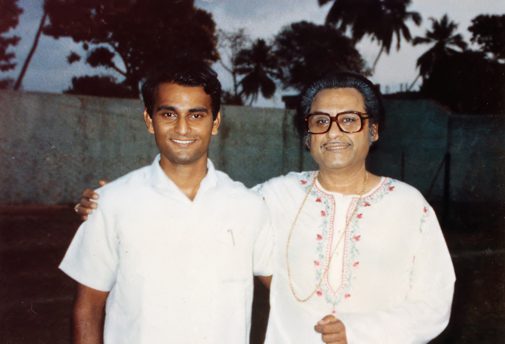
Rajan P. Parrikar with Kishore Kumar (Goa, 1986)
Namashkar.
The concluding episode of Short Takes explores the eponymous Raga Multani, a fitting finale to our discourse on the nature and structure of ragas. (Update: As it turned out, I wrote three more episodes in 2005 – RP.)
Throughout our discussion, M denotes shuddha madhyam, and m denotes teevra madhyam.
Raga Multani
Raga Multani belongs to the pantheon of ‘big’ ragas, cherished by musicians for its profound gravitas and expansive range. It offers a rich canvas for melodic exploration, demanding both skill and imagination. While its basic swaric framework is derived from the Todi that – S r g m P d N – Multani exhibits no trace of the Todi raganga. Instead, it presents a fully evolved and distinct swaroopa, an identity that is unmistakably its own.
Let us examine the raga lakshanas.
To recap the notational convention: a swara enclosed in brackets represents a kan (grace) to the swara immediately following it. The single quote ‘ on a swara (for example, P’) situates it in the mandra saptaka, the double quote ” (for example, S”) situates it in the tar saptaka.
S, N’ S g (S)r(N’)S
Both r and d are dropped in arohi prayogas; the avaroha is sampoorna. The peculiar uccharana (intonation) of r mediated by a kan of S is vital to Multani. Recall the vastly different behavior of Todi in this region, in its case a deergha r and an intimate coupling with g. An inopportune nyasa on the rishab is the kiss of death for Multani. Further divergence between Todi and Multani in matters concerning g is suggested in the next tonal strip.
N’ S (m)g m P, m P (m)g, m g (S)r(N’)S
Characteristic of Multani is the arohi uccharana of g: it is tugged with m as in (m)g (m)g m P. Since g is approached from m, it has the effect of raising the shruti of g to a level above its nominal komal value. This in turn has the effect of elevating the shruti of r. These microtonal nuances are later demonstrated tellingly by Pandit Ramashreya Jha “Ramrang.” The teevra madhyam in Multani is close to pancham, in the latter’s penumbra, as it were.
P, (m)g P, P (P)d(m)P, P (m)g, m g m g (S)r(N’)S
The treatment of d is congruent to that accorded r. The purnavritti (repetition) of m g in avarohi prayogas is a point of note. As is the langhan of m, occasionally from g to P and more often through a meend-laden avarohi P to g. The importance of the powerful pancham to Multani should be evident by now.
(m)g m P N, N, S”, S” g” (S”)r”(N)S”
The uttaranga launch proceeds thus, with a deergha N. The sharp m P N curve presents a source of discomfort to many a khayal singer especially in the faster passages; the tendency to instead detour through m d N must be checked.
S”, N S” N d P, m P (m)g, m g m g (S)r(N’)S
This sentence completes the overall avarohi picture.
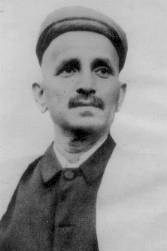
Vishnu Narayan Bhatkhande
Obiter dictum: In his magnum opus, Hindustani Sangeet Paddhati, Pandit Vishnu Narayan Bhatkhande observes that Multani is considered the daytime counterpart of the nightly Raga Basant. He adds that the Rampur musicians of the Tansen tradition sing a g-laden version of the latter by the name Utari Basant.
Pandit Ramashreya Jha “Ramrang” distills the essence of Raga Multani in this brilliant discourse recorded over the telephone.
Multani does not lend itself readily to the purveyors of ‘light’ music. Be that as it may, S.D. Burman springs a surprise with this gem from JEEVAN JYOTI (1953). Notice the superb harmonium work in the interludes. Mohammad Rafi and Geeta Dutt: laga gayeen akhiyan.
Amir Khan sings a bhajan for composer Naushad in SHABAB (1954): daya karo hey Girdhara Gopala.
The genre of Marathi natyageeta has drawn liberally from the classical reservoir. The song prema seva sharana originally tuned in Raga Bhimpalasi (see Abdul Karim Khan‘s rendition in Bhimpalasi Inc), was later cast by Dinanath Mangeshkar in Multani (for the most part).
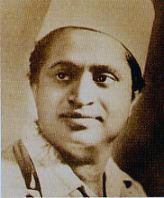
Dinanath Mangeshkar
Vasantrao Deshpande considered himself a pupil of Master Dinanath. He offers his own spin on prema seva.
The classical entrées that follow reveal that the Kirana musicians have in place a virtual lock here, having installed their instantiation of Multani as the gold standard.
We warm up to Bhimsen Joshi’s classic, a bold statement of the famous khayal, gokul gama ko chhora. The druta bandish is a Kirana specialty, kangana mundariya.
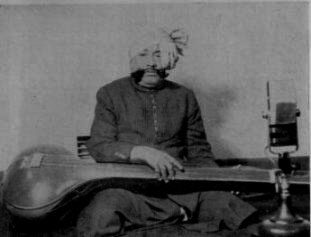
Abdul Wahid Khan
Abdul Karim Khan‘s old recording of the druta item.
The same cheez reprised by Roshanara Begum.
Acknowledged as a Kirana pioneer, Abdul Wahid Khan spent all of his performing career in the shadow of his trailblazing cousin Abdul Karim Khan. Abdul Wahid was among those early vocalists responsible for a paradigmatic shift to the leisurely vilambit laya in khayal gayaki. He was an exceptional teacher who trained a number of pupils, among them, Hirabai Barodekar, Sureshbabu Mane, Begum Akhtar and Pran Nath. But perhaps it is Abdul Wahid’s powerful influence on Amir Khan that supercedes his other attainments. He died in 1949 in Lahore. Here he deals a khayal in vilambit Jhoomra
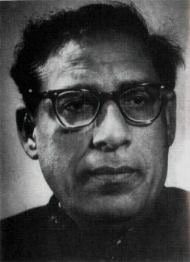
Amir Khan
Amir Khan’s Multani is the musical equivalent of Mt. Everest, the loftiest of them all.
An old composition by Omkarnath Thakur: surajana matwala.
The Gwalior musicians also sing a hybrid known as Multani-Dhanashree.
Next we turn to the Atrauli-Jaipur contingent.
Kesarbai Kerkar wields an old composition: ina durajana logava ko.
Moving along –
Satya Kinkar Bandopadhyaya (1899-1980), the former Dean of the music faculty at Rabindra Bharati University and a representative of the Vishnupur gharana, presents a bandish in Bengali: Shiva Shankara.
Enchanting exhibits line our instrumental kiosk.
Z.M. Dagar‘s magnificent alap on the Rudra Veena.
Mushtaq Ali Khan‘s sitar.
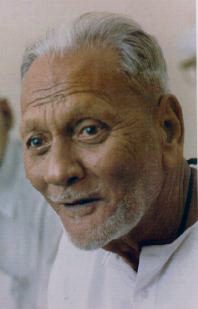
Bismillah Khan
The dispenser of melodic manna, Bismillah Khan.
If Amir Khan signifies the Mt. Everest, then Bade Ghulam Ali Khan‘s Multani is the Taj Mahal of melody. The traditional vilambit khayal: kavana des gaye piya.
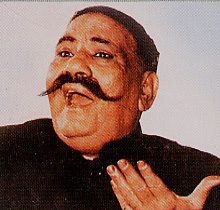
Bade Ghulam Ali Khan
Raga Madhuvanti/Ambika
This is a relatively recent raga with shared credits for its development. The sitariya Vilayat Khan is said to have conceived it sometime in the early 1940s. Independently and around the same time, Wamanrao Padhye of Kolhapur composed a similar raga and called it Ambika, after the Goddess.
Swara-wise Madhuvanti is attained to by rendering shuddha both rishab and dhaivat in the Multani contour. And although in the poorvanga there is an abhasa of Multani, the similarity stops there. Madhuvanti is pleasing to the ear but it carries neither the gravitas nor the range nor the intonational nuance that characterises Multani. Nevertheless, it has cultivated a devoted following and is frequently featured in the late afternoon sessions.
The Carnatic melakarta Raga Dharmavati resembles Madhuvanti. Its essence is now summarized.
N’ S (m)g m g (S)R, S
The tug of m attending g is reminiscent of Multani, but the crucial element in Madhuvanti is the deergha avarohi R through a kan of S.
(m)g m P, m P D P, (m)g m P N, N S” N, D m P
Pancham and nishad are locations for nyasa.
(m)g m P N, N S”, N S” g” R” S”, N S” D, D m P
Notice the deergha D and the prospect of a tirobhava due to Raga Patdeep from g” downward until the revival of Madhuvanti through m. Some musicians introduce komal nishad occasionally (for instance, via P n D P).
Pandit Ramashreya Jha “Ramrang” shares his thoughts on Raga Madhuvanti.
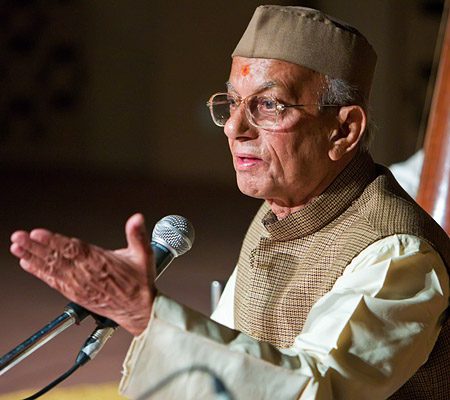
Pandit Ramashreya Jha “Ramrang”
Lata Mangeshkar‘s recitation from Chapter 15 of the Bhagavad Geeta.
The kanakadhaara stotram of Adi Shankara in the sublime voice of M.S. Subbulakshmi: sampatkaran sakalendriya.
MS again, in a bhajan composed by K. Venkataraman: guruvara deejo.
Composer Hridaynath Mangeshkar and Lata Mangeshkar combine in this Meerabai bhajan: ko birahini ko dukha jaanai ho.
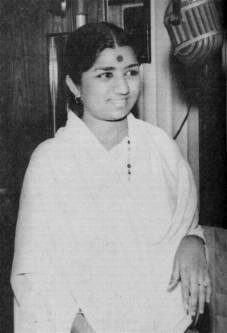
Lata Mangeshkar
Madan Mohan‘s beautiful composition in DIL KI RAHEIN (1973) calls on Lata: rasm-e-ulfat ko nibhaye.
Sudha Raghunathan sings a composition of the 15th C saint-composer Annamacharya: mangambudhi hanumantha.
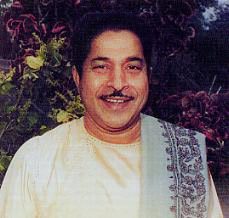
Jitendra Abhisheki
An old 78 rpm reveals a young and crisp Vilayat Khan.
Jitendra Abhisheki finds use for both nishads.
Bhimsen Joshi also flirts with komal nishad in intriguing ways in this commercial release. Although it is labeled as Hemavati, I have cast it in this section. The liner notes (by a British ethnopimp) assert that there is no pancham. Even a freshly born Indian baby can tell that the pancham, is, in fact, heard right away on the opening syllable of the mukhda, and that it figures prominently thereafter.
Bhimsen: kaahe maana karo.
Nazakat Ali Khan and Salamat Ali Khan.
A couple of compositions by Shubha Mudgal of which the first, bairana barkha rutu aayi, was composed by Kumar Gandharva.
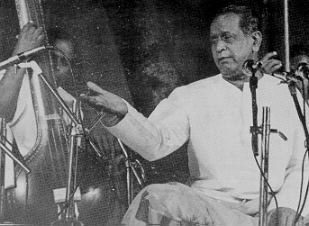
Bhimsen Joshi
An old 78 rpm cut of Ali Akbar Khan (aka Alu), the dark, dimunitive (naked) Emperor of San Rafael.
The Rampur sarangiyas, Hamid Hussain and Zahid Hussain, play a variation known as Tanseni Madhuvanti. The “Tanseni” presumably qualifies the special sangati with the two nishads à la Miyan Malhar.
We wrap up the Madhuvanti segment with the ethereal meditations of Bismillah Khan, the greatest Hindustani instrumentalist of our times.
Raga Hemavati
Hemavati is the 58th Carnatic melakarta: S R g m P D n, and the raga crystallized from this swara-set goes by the same name in Hindustani music. It is a fairly recent migrant.
Abdul Halim Jaffer Khan, Hemavati.
Raga Anjani Kalyan
Ramashreya Jha “Ramrang” has named his conception after Shri Hanuman. The basic idea involves rendering the arohana of Madhuvanti sampoorna by taking in both R and D. The arohi contour thus assumes the form S R g m P D N and permits the advance of Kalyan-like clusters (whence the Kalyan suffix in the name).
Jha-sahab’s delicious composition sings the glories of Hanuman:
hanana Hanuman maana ke
dalana danava ke jana ke palaka Lanka ke dahaka beera baanke
Rama ke payaka kapinha ke nayaka
“Ramrang” shamana santapa taapa namata pada jaake
Acknowledgements
My warm thanks to the usual cast of accomplices: Romesh Aeri, Ashok Ambardar, Sir Vish Krishnan, V.N. Muthukumar, Ajay Nerurkar and Dr. Guri Singh. Anita Thakur, as everyone knows by now, has been my partner-in-crime during the past three years.
Epilogue (January 2003)
For the past three years beginning in early 2000, I have been writing about the internal constitution of ragas. The proceedings of this inquiry are now part of the South Asian Women’s Forum (SAWF) archives. The time has come for me to call it a day. As can be gathered from the desultory arrangement of the topics, this set of articles was not planned, there was no conscious design to the undertaking. What began as an informal jaunt with a posting or two on the Usenet newsgroup rec.music.indian.classical (RMIC) on the urging of a couple of friends developed a life and momentum of its own. If I had had my way, I would have stopped after the first 2 or 3 episodes and returned to my default state of fainéant leisure. But at the time I had not appreciated the superior powers of persuasion – and coercion – of the charming girls of SAWF.
I like to view these ruminations in the spirit of entries made in a personal diary during the course of an unfinished journey through the universe of raga. And much like a travelogue, they include descriptions and opinions of the sights, sounds and objects encountered, records of emotional experiences, and recollections of those moments of frisson that cap the occasional instance of insight or surprise. I count it as my singular fortune to have had privileged access to the ride perched on the shoulders of vidwans of the calibre of Pandit Vishnu Narayan Bhatkhande and Pandit Ramashreya Jha “Ramrang.” I lay no claim to having accomplished anything original and readily cede ground on that score to the many ‘original’ worthies who walk this earth and to whom Dr. Johnson has paid handsome tribute: “Your manuscript is both original and good. But the part which is original is not good and the part which is good is not original.”
Raga – and the ananda it brings – is best experienced firsthand, by renewing and recreating it in the hallways of your own mind, not vicariously or through the written word. I am anxious that a raga not be viewed as merely an ensemble of rules defined by aroha and avaroha, vadi-samvadi pairs, and a tissue of characteristic phrases and chalans. A nyasa swara here and a skipped swara there are important and necessary details while speaking about raga, true. But where do these considerations come from? Are they merely whims ossified by convention? Or is there a deeper basis? My hope is that I have successfully suggested some of the answers. That at its foundations, Indian music is governed by what I refer to as The Laws of Melodic Ethics – the Indian term is Raga Dharma. Pandit Bhatkhande’s monumental achievement lay in seeing and abstracting the nature of these ‘laws’ from the thicket of melodic observations. What seem like ‘rules’ to the innocent eye are, upon contemplation, revealed to be ‘truths’ to the sadhaka, impulses that excite the deepest core of our brain. There is perhaps a neurological explanation to our response to elemental musical patterns. Pandit Einstein could well have been talking about Indian music when he wrote:
“It is the privilege of man’s moral genius, impersonated by inspired individuals, to advance ethical axioms which are so comprehensive and so well founded that men will accept them as grounded in the vast mass of their individual emotional experiences. Ethical axioms are founded and tested not very differently from the axioms of science. Truth is what stands the test of experience.” (vide Out of My Later Years.)
My other motivation at keeping up with this series has a less noble ring to it. By becoming engineers and doctors, India’s best minds today have ceded the business of researching and explicating India’s heritage to foreigners. These cultural outsiders – overwhelmingly Westerners – are mostly of third-rate intellectual quality (the smartest Americans are not studying India). Ours is perhaps the only major civilization whose primary interpretations in English are initiated and written by outsiders and then lapped up by our urban, English-educated elite as canonical. It is my unshakable conviction that India’s primary interpretations must come from those who have been brought up in, and who have lived and practiced, that tradition. Seeing ourselves through the Westerner’s lens won’t do any good (as a minor sidelight, consider the absurd label “South Asian” in SAWF, an identity foisted on us by the US State Department and accepted without demur).
A good number of Western academics ensconced in prestigious universities who are purportedly “friends” of India and Indian tradition have over the years revealed, in addition to mediocre scholarship, their unholy, selfish motives, and their racism, the latter cleverly disguised with suitable escape hatches. In this context, my views on the ethnopimps (they call themselves “ethnomusicologists”) do not bear repetition. Those Indians in the know seldom speak out publicly, thwarted by either the sheer ugliness of the issues involved or by the fear of giving offense. I wrote these articles as a way of saying to these Western vultures that we will henceforth not sit by silently while you prey on, misrepresent, mischaracterize and abuse our tradition. Notice has now been served: we will no longer be your “native informants” and your lab rats to be exploited en route to your career and tenure. Perhaps we are already beginning to see a faint shimmering of an Indian Renaissance. Rajiv Malhotra‘s outstanding work at The Infinity Foundation merits mention in this connection.
That said, it must be underscored that the best in India’s heritage belongs not just to Indians but to the whole human family. We are reminded of Rabindranath Tagore and his transcendental utterings, his mantra serving to guide our hearts, minds and spirit towards the ideal that presides over the enlightened, sattvic life:
“Whatever we understand and enjoy in human products instantly becomes ours, wherever they might have their origin. Let me feel with unalloyed gladness that all the great glories of man are mine.”
On that note, dhanyavaad and goodbye.
Rajan P. Parrikar
